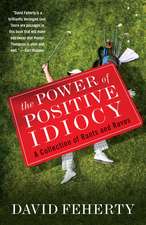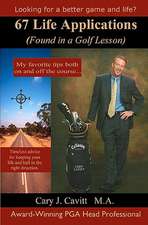Every Shot Must Have a Purpose
Autor Pia Nilsson, Lynn Marriott, Ron Siraken Limba Engleză Hardback – 31 oct 2005 – vârsta de la 18 ani
Two legendary coaches give golfers a powerful new approach to the game... and to life.
As coaches to some of golf’s top players, Pia Nilsson and Lynn Marriott have designed and refined a revolutionary way of teaching the game, with phenomenal results. They don’t believe in prescribing the same stance, grip, and swing to everyone, followed by hours of purposeless drilling. They don’t even believe in beginning with physical technique. Their success has proven to them that a great game begins with a great vision.
Unlike any other golf book, Every Shot Must Have a Purpose offers cutting-edge techniques for integrating the physical, technical, mental, emotional, and social parts of a player’s game. The book’s revolutionary pre-shot routine will improve your focus, leading to a golf swing that is not only successful but can be repeated under extreme pressure. Emphasizing the individual golfer rather than a rigid set of mechanics, their VISION54 method takes the frustration out of the game. Why 54? Because they believe it’s possible to shoot a 54 (making a birdie on every hole of a par-72 course) if you have the right mind-set and well-honed intuitive power.
An engaging read for the beginner or the seasoned golfer, Every Shot Must Have a Purpose is inspiration for life, not just the links.
As coaches to some of golf’s top players, Pia Nilsson and Lynn Marriott have designed and refined a revolutionary way of teaching the game, with phenomenal results. They don’t believe in prescribing the same stance, grip, and swing to everyone, followed by hours of purposeless drilling. They don’t even believe in beginning with physical technique. Their success has proven to them that a great game begins with a great vision.
Unlike any other golf book, Every Shot Must Have a Purpose offers cutting-edge techniques for integrating the physical, technical, mental, emotional, and social parts of a player’s game. The book’s revolutionary pre-shot routine will improve your focus, leading to a golf swing that is not only successful but can be repeated under extreme pressure. Emphasizing the individual golfer rather than a rigid set of mechanics, their VISION54 method takes the frustration out of the game. Why 54? Because they believe it’s possible to shoot a 54 (making a birdie on every hole of a par-72 course) if you have the right mind-set and well-honed intuitive power.
An engaging read for the beginner or the seasoned golfer, Every Shot Must Have a Purpose is inspiration for life, not just the links.
Preț: 143.35 lei
Nou
Puncte Express: 215
Preț estimativ în valută:
27.43€ • 28.58$ • 22.81£
27.43€ • 28.58$ • 22.81£
Carte disponibilă
Livrare economică 21 ianuarie-04 februarie 25
Preluare comenzi: 021 569.72.76
Specificații
ISBN-13: 9781592401574
ISBN-10: 1592401570
Pagini: 198
Dimensiuni: 142 x 192 x 21 mm
Greutate: 0.29 kg
Editura: GOTHAM BOOKS
ISBN-10: 1592401570
Pagini: 198
Dimensiuni: 142 x 192 x 21 mm
Greutate: 0.29 kg
Editura: GOTHAM BOOKS
Recenzii
"I have been impressed by Pia ever since I saw her in action in the late 1980’s, first as a player and then as my coach. Pia is open-minded and intelligent and possesses the desire to constantly help others develop... I have been inspired to follow her beliefs and life philosophy."
—Annika Sorenstam, LPGA
—Annika Sorenstam, LPGA
Notă biografică
Pia Nilsson and Lynn Marriott cofounded VISION54/Coaching for the Future, Inc. Their golf school, Golf54, in Phoenix, AZ was recently named Golf magazine's #1 in the nation. In addition to serving as Annika Sorenstam’s coach and coaching the Swedish national golf team, Nilsson has spoken at numerous conferences worldwide. Marriott has been named one of Golf Digest’s 50 Greatest Teachers and one of Golf Magazine’s 100 Top Teachers, coaching major figures such as Grace Park and Ken Kellaney.
Award-winning sportswriter Ron Sirak is executive editor of Golf World and a senior writer at Golf Digest.
Award-winning sportswriter Ron Sirak is executive editor of Golf World and a senior writer at Golf Digest.
Extras
Introduction
8Imagine the Impossible; Then Figure Out How to Make It Happene
=Ron Sirak
8The secret of success is constancy to purpose.e
=Benjamin Disraeli, nineteenth-century English prime minister
What you are about to read is a golf book unlike any other. Through years of teaching players of all different skill levels=from beginners to top professionals=Pia Nilsson and Lynn Marriott have refined an approach to instruction that is not bogged down in arm angles, spine positions, and swing thoughts so complex they would make the average golferfs brain freeze with confused indecision. Rather, VISION54, the revolutionary approach to the game that Pia developed in Sweden twenty years ago and that she refined with Lynn as GOLF54, teaches that peak performance on the golf course is achieved by simplifying the game, not by burdening the pupil with overly technical instruction. As Pia and Lynn say, 8Itfs all about the person first.eWhat you will find in these pages is a life philosophy, not merely a golf instruction book. It is the most radical departure from traditional golf instruction yet to come along. VISION54 teaches us to expand our concept of limits. GOLF54 provides the tools that make it possible for us to achieve our vision. The intuitive intelligence of Pia and Lynnfs approach reduces the game to such a basic and accessible level that you will frequently find yourself, as I did, shaking your head and saying, 8Of course,e when they point out an obvious aspect of the game that has been obscured by what they call the Pez Dispenser School of Instruction=8Bend your knees, thirty bucks please.e GOLF54 takes us back to the reason we started to play golf in the first place: Itfs fun. It is in the rediscovery of that joy that Pia and Lynn teach us how to find the keys to better play.
One of the disturbing trends the golf industry has to confront is the fact that in the United States as many people quit the game each year as take it up. While cost and the time required to play a round of golf are significant reasons for this trend, many are also driven away because the game becomes more of a struggle than an enjoyable experience. When a troubled golfer tries to get help, he or she will most likely be given a series of instructions that would require a much more talented athlete and a serious amount of time to master. Completely rebuilding a swing is not only impractical for most players, it is also unnecessary. You have hit good shots with the swing you have. You have hit perfect shots with the swing you have. This book will teach you how to make those shots happen more often. You donft need a new swing; you need a more defined sense of purpose.
I had known about Pia for many years as a player, a coach, and a European Solheim Cup captain, and had long been fascinated by her novel approach to instruction. I knew of her astonishing success with Annika Sorenstam and I was aware of the rebellion against her by some of the tradition-bound players when she tried to bring her innovative approach to the 1998 Solheim Cup team. But I did not really get to know Pia and Lynn until 2003, when Sorenstam decided she would play in a menfs event on the PGA Tour. I interviewed Pia soon after Annika announced her intentions and revisited the conversation several times in the months leading up to the Bank of America Colonial. After listening carefully to Annikafs words, a light went on in my head. 8Of course,e I said to myself. 8Itfs so obvious.e Words you will say time and again as you read this book.
I called Pia and said, 8It doesnft matter what Annika shoots at Colonial, right? And it doesnft even matter if she makes the cut, right? All that matters for Annika to consider the experience a success is if she feels she has handled the enormity of the moment well.e Pia, who punctuates life with an exclamation point, laughed and said, 8You got it!e I know some teachers who would have then added, 8What took you so long?e But that is not the way of Pia and Lynn. They lead you to knowledge. Understanding is up to you. Commitment is up to you. Sorenstam did not make the cut at Colonial, but her opening round of 71 was a ball-striking performance of such perfection that womenfs golf gained new respect instantly and more than just fans of the LPGA finally appreciated Annikafs skills. GOLF54 was a key component in how well Annika handled the pressure of that day.
It was at Colonial that I had my first extensive conversation with Lynn Marriott, who has been a Class A teaching professional since 1983. Lynn graduated cum laude with a degree in marketing and management from Penn State University, but she could just as easily hang out her shingle as a psychologist. Her numerous courses and seminars have as much to do with communication, leadership, mental training, and the psychology of how to coach as they do with golf. It was Lynn who made THINK BOX/PLAY BOX, which is so essential to GOLF54 teaching, come to life, and made it a real experience. If Pia punctuates life with an exclamation point, Lynn approaches the process with a question mark. Like any good therapist, she provides answers by asking shrewd questions. Lynn has always had a vision of a whole-game approach. It was clear to her as a young teacher that the golf swing does not equal golf.
In April of 2004, I went to Pia and Lynnfs school at the Legacy Golf Resort in Phoenix. When I left for three days of instruction, friends who had been to other golf schools told me how much my hands would hurt and my muscles would ache after days of beating balls. Clearly, they had never been students of Pia and Lynn. The biggest breakthroughs were made when the ten of us in the class were sitting in a circle, laughing and collectively grasping one of their concepts. As much was accomplished in discussions over dinner or lunch as was accomplished on the range. When we hit balls or when we went out onto the course it was with the drills and exercises you will learn in these pages. Instead of complex theory, we learned the focus that allows the good shots within us to come out more often. We practiced with a purpose, and we played with a purpose.
I wish I had met Pia and Lynn years ago. Not just because it would have helped my game=which it has=but also because it would have made me a better golf writer. Now, since I understand their method better, I understand Annika Sorenstam better. I look at her with new eyes and appreciate that everything she does at a tournament=from where she stays and whom she stays with to where she eats and when she practices and how she practices=has a purpose. I watch her routine on the golf course and I smile inwardly when she steps into the THINK BOX and then moves with total commitment across the DECISION LINE into the PLAY BOX.
I watch other players, and when they struggle I can spot the physical and mental errors Pia and Lynn have taught me to be aware of in my own game. I also wish I had met Pia and Lynn earlier because, in addition to improving me as a player and as a writer=I now employ many of the philosophies in this book in the way I approach work=they have also improved me as a person. They are two very special people whose approach to teaching is rooted not just in a love of the game but also in an appreciation of and respect for the individual.
Their approach=GOLF54=will teach you how to develop routines you can trust and it will teach you how to transfer those routines from the practice range to the golf course. It will teach you how to embrace your ability and how to discover, in that embrace, the secrets of moving closer to achieving your ultimate potential. There is good golf within you. Pia and Lynn will help you bring it out more often.
CHAPTER I
Forget What You Know,
Learn What You Know
8Learning is experience. Everything else is just information.e
=Albert Einstein, twentieth-century scientist
SWING KEY: Empty your head so wisdom can flow in.
All golf instruction books promise to lower your score. We promise to make you a better player. You decide what that will do for your handicap. What we offer is not a quick fix providing temporary results but rather a new perspective that will allow you to maximize your abilities and approach your peak performance more often=and more reliably under pressure=no matter what your skill level. We will show you how to become much more than a mere student of the swing. If you are a beginner, you will learn how to play better sooner on the golf course. If you have been playing for a while, you will learn how to score lower. No matter what your skill level, you will learn how to enjoy the game more. You will learn how to make golf a game you love, not one you fear.
How are we going to make you a better player? Well, it is absurd to think that we can change your swing with a book. For one thing, wefve never seen your swing. How can we change it? While there are certain mechanical fundamentals essential to playing the game=grip, stance, posture, etc.=we believe there is more than one right way to swing a golf club. And we believe that golf is far more than merely the physical act of swinging a club. Your fundamental problems are probably not with the way you swing but rather with the way you approach the game.
How many times have you taken a swing tip to the golf course and found that it was a magic elixir for a few rounds, only to wear off when you needed it most? How many times have you hit the ball great on the range only to lose it when the round starts? Thatfs because traditional instruction separates the swing from the person, and it separates practice from real golf. We integrate the two. GOLF54 is not about teaching; it is about learning. Most approaches to instruction focus on the teacherfs knowledge; we focus on the studentfs potential. A lesson well learned becomes your teacher for life. Everyone who swings a golf club has hit a good shot at one time or another. We will show you how to open the door that will allow those good shots to come out more often.
What we offer is a radical departure from traditional golf instruction. The current culture of instruction leads you to believe that the technical is the only piece of the puzzle that matters. This kind of teaching reduces the gloriously fluid, decidedly sensual experience of the golf swing to nothing more than angles and elbows. We call this the Pez Dispenser School of Golf=8Bend your knees, thirty bucks pleasee=talking heads spewing advice that has very little, if anything, to do with the person swinging the club. They believe in teaching you; we believe in having you learn. There is a big difference.
The conventional way of instruction is also a school of thought that creates a dependent relationship between the student and the teacher. We believe in the Socratic coaching method. We want you to learn to coach yourself by helping you to understand yourself better and by showing you how to draw out your own abilities. You are always with yourself on the golf course. What more reliable coach could you have?
Absolutely essential to our approach is the notion that you should only concern yourself with the things that are under your control. Not only should every shot have a purpose, but every action should have a purpose as well. And the purpose of golf is all about getting the ball in the hole=pure and simple. Why make the game any more complicated than that? There is a ton of truth in the old clich+: 8They donft ask you how, they ask how many.e Donft waste energy fretting about those things over which you have no control. When you do that, all you are doing is borrowing trouble.
To get the ball in the hole as efficiently as possible, you must channel your energies only toward those things you can influence. We call these things CONTROLLABLE GOALS. Score is not a controllable goal. Neither is winning. Bad bounces, bad weather, an opponent having a career day, and endless other things all take control out of your hands in regard to score and winning. You will learn how to develop a PLAYING FOCUS that will keep your mind centered on the task at hand=hitting the shot you are about to play.
What do we mean by PLAYING FOCUS? It includes things like preparation, focus, tempo, and commitment. How many times have you been playing well when a thought such as this crossed your mind: 8Gee, if I play the last five holes two over par I can shoot my career-best rounde? And how often is it the case that, almost as soon as you start adding up your score, the round falls apart? You have let your focus shift from the controllable=your PLAYING FOCUS=to the uncontrollable=your score.
Letfs take practice as an example of an aspect of your game over which you have definite control. Many players spend a lot of time and energy on the practice range, hit the ball great there, and donft get any better when they take their game out on the course. Thatfs because they practice in a context that has nothing to do with the game of golf. So much of teaching in this game is economically driven. Herefs my twenty bucks, give me a bucket of balls. Scrape and hit, scrape and hit. Give myself a perfect lie and hit the shot. The balls are gone. I must be done practicing. If you are going to practice, make it useful time, not time used up.
A lot of players will wear blistered hands as a badge of honor showing how hard they have worked. But what was accomplished? Most players develop Golf Attention Deficit Disorder (GADD) because of a practice culture that teaches us to value quantity over quality. The practice of standing on the range hitting one hundred balls with little thought and no purpose is actually teaching your mind to be less focused on the golf course and it is encouraging your swing to be less disciplined. And you wonder why the player you are on the range is not the same player who shows up on the course! With our approach you will learn how to cultivate a PLAYING FOCUS on the range that works for you on the golf course.
Bobby Jones said there is golf and then there is tournament golf. He was right. There is also practice golf and real golf. We will show you how to integrate the two. Part of our message is that if you want to score better, simulate real golf when you practice. You will learn how to do this through simple drills and enjoyable games that will make your practice not only more productive but also more fun. You will also learn how to use the gamefs proving ground=the golf course=as a practice facility. The course should be not just a proving ground but a learning ground as well.
Most people practice by giving themselves a perfect lie and then hitting a dozen shots with the same club at the same target. How is that like real golf? How often do you do that on the golf course? How often in a round do you hit even two 8-irons in a row? Rarely, we hope! Switch clubs after every shot. Switch targets. If you are working on the takeaway, maybe you donft even need a ball in front of you. Just work on the takeaway. Ask yourself: Whatfs my INTENTION? And then ask: Am I paying ATTENTION to that? When you practice you should be grooving not only your swing but also your mind. Take putting as another example. Why do people practice by putting with three balls to one target? Is that the way you do it on the course? Why not practice with one ball to a different hole each time? Why not practice your putting by chipping and then putting, the way you would on a course? Why not simulate the pressure you experience on the golf course in practice by saying you want to make up-and-down five consecutive times before you stop practicing? Make your brain recalibrate after every shot. That is far more important to a productive practice session than the number of balls you hit or the number of hours you put in.
The traditional way of practicing makes you better on the range, but it does not transfer to the course because it has nothing to do with the reality of golf. Remember, every shot must have a purpose, even in practice. That is where the habit of good golf is formed. That is where you learn what you can trust, and develop trust in what you have learned.
The most common cry we hear from golfers of all skill levels is that they want to be more consistent. By paying more attention to your practice and to the way you perform on the golf course, you will discover that you are more consistent than you think. It is one definition of insanity to keep doing the same thing with no success but to continue to repeat the process hoping for a different outcome. It is also the action of a person who is not paying ATTENTION to his INTENTION. Remember, our worst tendencies show up under pressure. Pay attention. Take notes. Write them down. Do the same when you play your best golf. Try to understand what is going on and how you are feeling when you play well. Your consistency lies in the fact that you mess up in the same ways and you succeed in the same ways. Learn to recognize both and learn to understand both. Call it golf therapy. To do this you will need to discard some of what you have been taught about golf. You will need to empty your head so wisdom can flow in.
As you must have clear intentions in order to become a better golfer, so we must have clear intentions to become better teachers. Here are the beliefs we bring to our coaching:
n Each human is unique.
n Each human has unlimited potential.
n Distinguish between who you are and what you do.
n Golf is a game to be played.
n Developing balance is essential.
n Performance is about getting the ball in the hole.
n No one is broken. Every human being can develop.
n The physical, technical, mental, emotional, and social parts of golf and life are integrated.
n Learning is a lifetime process.
Thatfs who we are. Now, letfs start to learn more about who you are by asking yourself these questions:
n If you could be any golfer in the world, who would you like to be?
n When did you show the most courage ever?
n What is the best golf shot you ever hit?
n If golf could be even more fun, how would that be?
n Whatfs the thing you are best at?
n What is the one thing you are most proud of in your golf?
n Whatfs the most fun you have ever had on a golf course?
In more than two decades of working with players of all skill levels=from beginners to those playing professionally=we have found some startlingly similar signposts that lead to success. A successful golf swing is not always a pretty golf swing. A successful golf swing is one that repeats, especially under pressure. And nothing sabotages a golf swing more successfully than tension, those times when you grip the club too tightly or swing too fast or just get so angry you canft think straight. Tension comes from fear, and fear comes from a lack of confidence and a loss of trust. You will learn how to find that trust in your abilities, and how to rediscover it when it seems to be slipping away.
Wefve all had that experience of standing over a golf shot and feeling absolutely certain in our heart of hearts that the ball is going to follow the flight we imagine in our minds. And we have also all had the feeling of standing over a shot afraid to start the backswing because we feel that we have no idea where the ball is going to go. Yet itfs the same person holding the same club and bringing to the shot the same mechanics that have proven to work in the past.
Whatfs the difference? Attitude. Actually, it is more than just attitude. It is perception and state of mind. Thatfs what we are going to change in the following pages: how you approach the game and how you perceive the game. We will teach you how to practice with a purpose and how to play with a purpose. Through our approach=GOLF54=you will learn how to develop routines you can trust and how to transfer those routines from the range to the golf course. You will learn how to embrace your ability to achieve your ultimate potential.
Do you want to take your game from the driving range to the golf course? Do you want to see the hours of effort you put into practice result in lower scores on the golf course? Do you want to swing better? Do you want to think better on the golf course? Do you want better emotional control under pressure? Do you want to integrate all of this? Then GOLF54 is for you.
Why do we call our approach GOLF54? It is a philosophy Pia developed when she was head coach of the Swedish National Team, and Pia and Lynn have since expanded and refined it. While the cultural concern with fairness in Sweden produces good people, it does not promote the creation of peak-performance athletes. Pia found that Swedish golfers set their goals too low=and that low goals were exactly what they achieved. The only way to break out of this box of limited achievement is to set loftier expectations. What would be the most outrageous goal in golf? How about eighteen consecutive birdies=a 54 on a par-72 course. Traditional thinking says, 8Thatfs impossible. How can anyone shoot 54?e But progress is always a break with tradition. It is a paradigm shift. We say: Imagine the impossible, and then figure out how to make it happen. You are capable of hitting a perfect shot=youfve done it. You will learn how to string those shots together. You will learn how to have your own VISION54.
One of the players on Piafs Swedish National Team was a promising young woman named Annika Sorenstam. She was talented but shy, the perfect model of the Swedish athlete who wanted success but shunned the spotlight that comes with it. Her shyness and determination, however, became the perfect breeding ground for big dreams. Most comfortable in her solitude, she brilliantly built walls against the distractions around her and focused on the game of golf.
With a passion sometimes mistaken for aloofness, Sorenstam looked inside and found the focus that allowed her to maximize her potential on the golf course, eventually becoming the first woman to shoot 59 in an LPGA event and the first woman in fifty-eight years to play in a PGA Tour event. Annika is the embodiment of the spirit of GOLF54. She sets lofty goals and then devises strategies to realize them. She understands that the impossible is merely the stringing together of the possible. And she is one of the absolute best at focusing only on the things she can control.
8I think itfs possible to shoot 54,e Sorenstam says. 8Birdie Number one, birdie Number two, birdie Number three. I believe you can hit every fairway, I believe you can hit every green, and why not one putt? That makes a 54. Try to make it as simple as possible.e How does such an audacious goal relate to the average golfer? Well, it speaks to the nagging question asked by everyone, from the occasional recreational player to the committed professional: 8If I can hit one good shot, why canft I hit two in a row? If I can play one hole well, why canft I play eighteen holes well? If I can play one round well, why canft I play well every time out?e
We say there is absolutely no reason why that cannot be the case. GOLF54 will put you more in touch with your ability so you can approach your ultimate potential. For some, such as Annika, that potential includes a 54. For others it means a more reliable=and more enjoyable=experience on the golf course. Next time you see Annika playing, look at the headcover on her 7-wood. It is a knit cover in the blue and yellow of the Swedish flag with the number 54 on it. It is to remind Annika to keep VISION54 in her focus. We believe we can teach you your own VISION54.
When Ben Hogan, the person most people say invented practice, was asked the key to his success as a golfer, he liked to say, 8The secret is in the dirt.e But we think old Ben was holding out on everyone. When Hogan practiced, it was always with a purpose. When he played it was always with a passion. No one was ever more prepared for a competitive round than Hogan was, and few have had as much trust in their routine as Hogan. That trust was formulated long before he stepped to the first tee.
Hogan used to warm up for each competitive round by hitting the shots in the order he was going to hit them on the golf course. Once, a few weeks before the 1951 U.S. Open, a friend came upon Hogan practicing by himself at his home course in Texas, hitting knockdown 150-yard 5-irons. When asked what he was doing, Hogan replied: 8Ifm going to need that shot at Oakland Hills.e Yes, practice will make you better, but only if you practice the right things and approach practice in the right way=only if you practice with a purpose, only if you play with a purpose. The secret is not in the dirt, it is in you. Wefll help you find it."
8Imagine the Impossible; Then Figure Out How to Make It Happene
=Ron Sirak
8The secret of success is constancy to purpose.e
=Benjamin Disraeli, nineteenth-century English prime minister
What you are about to read is a golf book unlike any other. Through years of teaching players of all different skill levels=from beginners to top professionals=Pia Nilsson and Lynn Marriott have refined an approach to instruction that is not bogged down in arm angles, spine positions, and swing thoughts so complex they would make the average golferfs brain freeze with confused indecision. Rather, VISION54, the revolutionary approach to the game that Pia developed in Sweden twenty years ago and that she refined with Lynn as GOLF54, teaches that peak performance on the golf course is achieved by simplifying the game, not by burdening the pupil with overly technical instruction. As Pia and Lynn say, 8Itfs all about the person first.eWhat you will find in these pages is a life philosophy, not merely a golf instruction book. It is the most radical departure from traditional golf instruction yet to come along. VISION54 teaches us to expand our concept of limits. GOLF54 provides the tools that make it possible for us to achieve our vision. The intuitive intelligence of Pia and Lynnfs approach reduces the game to such a basic and accessible level that you will frequently find yourself, as I did, shaking your head and saying, 8Of course,e when they point out an obvious aspect of the game that has been obscured by what they call the Pez Dispenser School of Instruction=8Bend your knees, thirty bucks please.e GOLF54 takes us back to the reason we started to play golf in the first place: Itfs fun. It is in the rediscovery of that joy that Pia and Lynn teach us how to find the keys to better play.
One of the disturbing trends the golf industry has to confront is the fact that in the United States as many people quit the game each year as take it up. While cost and the time required to play a round of golf are significant reasons for this trend, many are also driven away because the game becomes more of a struggle than an enjoyable experience. When a troubled golfer tries to get help, he or she will most likely be given a series of instructions that would require a much more talented athlete and a serious amount of time to master. Completely rebuilding a swing is not only impractical for most players, it is also unnecessary. You have hit good shots with the swing you have. You have hit perfect shots with the swing you have. This book will teach you how to make those shots happen more often. You donft need a new swing; you need a more defined sense of purpose.
I had known about Pia for many years as a player, a coach, and a European Solheim Cup captain, and had long been fascinated by her novel approach to instruction. I knew of her astonishing success with Annika Sorenstam and I was aware of the rebellion against her by some of the tradition-bound players when she tried to bring her innovative approach to the 1998 Solheim Cup team. But I did not really get to know Pia and Lynn until 2003, when Sorenstam decided she would play in a menfs event on the PGA Tour. I interviewed Pia soon after Annika announced her intentions and revisited the conversation several times in the months leading up to the Bank of America Colonial. After listening carefully to Annikafs words, a light went on in my head. 8Of course,e I said to myself. 8Itfs so obvious.e Words you will say time and again as you read this book.
I called Pia and said, 8It doesnft matter what Annika shoots at Colonial, right? And it doesnft even matter if she makes the cut, right? All that matters for Annika to consider the experience a success is if she feels she has handled the enormity of the moment well.e Pia, who punctuates life with an exclamation point, laughed and said, 8You got it!e I know some teachers who would have then added, 8What took you so long?e But that is not the way of Pia and Lynn. They lead you to knowledge. Understanding is up to you. Commitment is up to you. Sorenstam did not make the cut at Colonial, but her opening round of 71 was a ball-striking performance of such perfection that womenfs golf gained new respect instantly and more than just fans of the LPGA finally appreciated Annikafs skills. GOLF54 was a key component in how well Annika handled the pressure of that day.
It was at Colonial that I had my first extensive conversation with Lynn Marriott, who has been a Class A teaching professional since 1983. Lynn graduated cum laude with a degree in marketing and management from Penn State University, but she could just as easily hang out her shingle as a psychologist. Her numerous courses and seminars have as much to do with communication, leadership, mental training, and the psychology of how to coach as they do with golf. It was Lynn who made THINK BOX/PLAY BOX, which is so essential to GOLF54 teaching, come to life, and made it a real experience. If Pia punctuates life with an exclamation point, Lynn approaches the process with a question mark. Like any good therapist, she provides answers by asking shrewd questions. Lynn has always had a vision of a whole-game approach. It was clear to her as a young teacher that the golf swing does not equal golf.
In April of 2004, I went to Pia and Lynnfs school at the Legacy Golf Resort in Phoenix. When I left for three days of instruction, friends who had been to other golf schools told me how much my hands would hurt and my muscles would ache after days of beating balls. Clearly, they had never been students of Pia and Lynn. The biggest breakthroughs were made when the ten of us in the class were sitting in a circle, laughing and collectively grasping one of their concepts. As much was accomplished in discussions over dinner or lunch as was accomplished on the range. When we hit balls or when we went out onto the course it was with the drills and exercises you will learn in these pages. Instead of complex theory, we learned the focus that allows the good shots within us to come out more often. We practiced with a purpose, and we played with a purpose.
I wish I had met Pia and Lynn years ago. Not just because it would have helped my game=which it has=but also because it would have made me a better golf writer. Now, since I understand their method better, I understand Annika Sorenstam better. I look at her with new eyes and appreciate that everything she does at a tournament=from where she stays and whom she stays with to where she eats and when she practices and how she practices=has a purpose. I watch her routine on the golf course and I smile inwardly when she steps into the THINK BOX and then moves with total commitment across the DECISION LINE into the PLAY BOX.
I watch other players, and when they struggle I can spot the physical and mental errors Pia and Lynn have taught me to be aware of in my own game. I also wish I had met Pia and Lynn earlier because, in addition to improving me as a player and as a writer=I now employ many of the philosophies in this book in the way I approach work=they have also improved me as a person. They are two very special people whose approach to teaching is rooted not just in a love of the game but also in an appreciation of and respect for the individual.
Their approach=GOLF54=will teach you how to develop routines you can trust and it will teach you how to transfer those routines from the practice range to the golf course. It will teach you how to embrace your ability and how to discover, in that embrace, the secrets of moving closer to achieving your ultimate potential. There is good golf within you. Pia and Lynn will help you bring it out more often.
CHAPTER I
Forget What You Know,
Learn What You Know
8Learning is experience. Everything else is just information.e
=Albert Einstein, twentieth-century scientist
SWING KEY: Empty your head so wisdom can flow in.
All golf instruction books promise to lower your score. We promise to make you a better player. You decide what that will do for your handicap. What we offer is not a quick fix providing temporary results but rather a new perspective that will allow you to maximize your abilities and approach your peak performance more often=and more reliably under pressure=no matter what your skill level. We will show you how to become much more than a mere student of the swing. If you are a beginner, you will learn how to play better sooner on the golf course. If you have been playing for a while, you will learn how to score lower. No matter what your skill level, you will learn how to enjoy the game more. You will learn how to make golf a game you love, not one you fear.
How are we going to make you a better player? Well, it is absurd to think that we can change your swing with a book. For one thing, wefve never seen your swing. How can we change it? While there are certain mechanical fundamentals essential to playing the game=grip, stance, posture, etc.=we believe there is more than one right way to swing a golf club. And we believe that golf is far more than merely the physical act of swinging a club. Your fundamental problems are probably not with the way you swing but rather with the way you approach the game.
How many times have you taken a swing tip to the golf course and found that it was a magic elixir for a few rounds, only to wear off when you needed it most? How many times have you hit the ball great on the range only to lose it when the round starts? Thatfs because traditional instruction separates the swing from the person, and it separates practice from real golf. We integrate the two. GOLF54 is not about teaching; it is about learning. Most approaches to instruction focus on the teacherfs knowledge; we focus on the studentfs potential. A lesson well learned becomes your teacher for life. Everyone who swings a golf club has hit a good shot at one time or another. We will show you how to open the door that will allow those good shots to come out more often.
What we offer is a radical departure from traditional golf instruction. The current culture of instruction leads you to believe that the technical is the only piece of the puzzle that matters. This kind of teaching reduces the gloriously fluid, decidedly sensual experience of the golf swing to nothing more than angles and elbows. We call this the Pez Dispenser School of Golf=8Bend your knees, thirty bucks pleasee=talking heads spewing advice that has very little, if anything, to do with the person swinging the club. They believe in teaching you; we believe in having you learn. There is a big difference.
The conventional way of instruction is also a school of thought that creates a dependent relationship between the student and the teacher. We believe in the Socratic coaching method. We want you to learn to coach yourself by helping you to understand yourself better and by showing you how to draw out your own abilities. You are always with yourself on the golf course. What more reliable coach could you have?
Absolutely essential to our approach is the notion that you should only concern yourself with the things that are under your control. Not only should every shot have a purpose, but every action should have a purpose as well. And the purpose of golf is all about getting the ball in the hole=pure and simple. Why make the game any more complicated than that? There is a ton of truth in the old clich+: 8They donft ask you how, they ask how many.e Donft waste energy fretting about those things over which you have no control. When you do that, all you are doing is borrowing trouble.
To get the ball in the hole as efficiently as possible, you must channel your energies only toward those things you can influence. We call these things CONTROLLABLE GOALS. Score is not a controllable goal. Neither is winning. Bad bounces, bad weather, an opponent having a career day, and endless other things all take control out of your hands in regard to score and winning. You will learn how to develop a PLAYING FOCUS that will keep your mind centered on the task at hand=hitting the shot you are about to play.
What do we mean by PLAYING FOCUS? It includes things like preparation, focus, tempo, and commitment. How many times have you been playing well when a thought such as this crossed your mind: 8Gee, if I play the last five holes two over par I can shoot my career-best rounde? And how often is it the case that, almost as soon as you start adding up your score, the round falls apart? You have let your focus shift from the controllable=your PLAYING FOCUS=to the uncontrollable=your score.
Letfs take practice as an example of an aspect of your game over which you have definite control. Many players spend a lot of time and energy on the practice range, hit the ball great there, and donft get any better when they take their game out on the course. Thatfs because they practice in a context that has nothing to do with the game of golf. So much of teaching in this game is economically driven. Herefs my twenty bucks, give me a bucket of balls. Scrape and hit, scrape and hit. Give myself a perfect lie and hit the shot. The balls are gone. I must be done practicing. If you are going to practice, make it useful time, not time used up.
A lot of players will wear blistered hands as a badge of honor showing how hard they have worked. But what was accomplished? Most players develop Golf Attention Deficit Disorder (GADD) because of a practice culture that teaches us to value quantity over quality. The practice of standing on the range hitting one hundred balls with little thought and no purpose is actually teaching your mind to be less focused on the golf course and it is encouraging your swing to be less disciplined. And you wonder why the player you are on the range is not the same player who shows up on the course! With our approach you will learn how to cultivate a PLAYING FOCUS on the range that works for you on the golf course.
Bobby Jones said there is golf and then there is tournament golf. He was right. There is also practice golf and real golf. We will show you how to integrate the two. Part of our message is that if you want to score better, simulate real golf when you practice. You will learn how to do this through simple drills and enjoyable games that will make your practice not only more productive but also more fun. You will also learn how to use the gamefs proving ground=the golf course=as a practice facility. The course should be not just a proving ground but a learning ground as well.
Most people practice by giving themselves a perfect lie and then hitting a dozen shots with the same club at the same target. How is that like real golf? How often do you do that on the golf course? How often in a round do you hit even two 8-irons in a row? Rarely, we hope! Switch clubs after every shot. Switch targets. If you are working on the takeaway, maybe you donft even need a ball in front of you. Just work on the takeaway. Ask yourself: Whatfs my INTENTION? And then ask: Am I paying ATTENTION to that? When you practice you should be grooving not only your swing but also your mind. Take putting as another example. Why do people practice by putting with three balls to one target? Is that the way you do it on the course? Why not practice with one ball to a different hole each time? Why not practice your putting by chipping and then putting, the way you would on a course? Why not simulate the pressure you experience on the golf course in practice by saying you want to make up-and-down five consecutive times before you stop practicing? Make your brain recalibrate after every shot. That is far more important to a productive practice session than the number of balls you hit or the number of hours you put in.
The traditional way of practicing makes you better on the range, but it does not transfer to the course because it has nothing to do with the reality of golf. Remember, every shot must have a purpose, even in practice. That is where the habit of good golf is formed. That is where you learn what you can trust, and develop trust in what you have learned.
The most common cry we hear from golfers of all skill levels is that they want to be more consistent. By paying more attention to your practice and to the way you perform on the golf course, you will discover that you are more consistent than you think. It is one definition of insanity to keep doing the same thing with no success but to continue to repeat the process hoping for a different outcome. It is also the action of a person who is not paying ATTENTION to his INTENTION. Remember, our worst tendencies show up under pressure. Pay attention. Take notes. Write them down. Do the same when you play your best golf. Try to understand what is going on and how you are feeling when you play well. Your consistency lies in the fact that you mess up in the same ways and you succeed in the same ways. Learn to recognize both and learn to understand both. Call it golf therapy. To do this you will need to discard some of what you have been taught about golf. You will need to empty your head so wisdom can flow in.
As you must have clear intentions in order to become a better golfer, so we must have clear intentions to become better teachers. Here are the beliefs we bring to our coaching:
n Each human is unique.
n Each human has unlimited potential.
n Distinguish between who you are and what you do.
n Golf is a game to be played.
n Developing balance is essential.
n Performance is about getting the ball in the hole.
n No one is broken. Every human being can develop.
n The physical, technical, mental, emotional, and social parts of golf and life are integrated.
n Learning is a lifetime process.
Thatfs who we are. Now, letfs start to learn more about who you are by asking yourself these questions:
n If you could be any golfer in the world, who would you like to be?
n When did you show the most courage ever?
n What is the best golf shot you ever hit?
n If golf could be even more fun, how would that be?
n Whatfs the thing you are best at?
n What is the one thing you are most proud of in your golf?
n Whatfs the most fun you have ever had on a golf course?
In more than two decades of working with players of all skill levels=from beginners to those playing professionally=we have found some startlingly similar signposts that lead to success. A successful golf swing is not always a pretty golf swing. A successful golf swing is one that repeats, especially under pressure. And nothing sabotages a golf swing more successfully than tension, those times when you grip the club too tightly or swing too fast or just get so angry you canft think straight. Tension comes from fear, and fear comes from a lack of confidence and a loss of trust. You will learn how to find that trust in your abilities, and how to rediscover it when it seems to be slipping away.
Wefve all had that experience of standing over a golf shot and feeling absolutely certain in our heart of hearts that the ball is going to follow the flight we imagine in our minds. And we have also all had the feeling of standing over a shot afraid to start the backswing because we feel that we have no idea where the ball is going to go. Yet itfs the same person holding the same club and bringing to the shot the same mechanics that have proven to work in the past.
Whatfs the difference? Attitude. Actually, it is more than just attitude. It is perception and state of mind. Thatfs what we are going to change in the following pages: how you approach the game and how you perceive the game. We will teach you how to practice with a purpose and how to play with a purpose. Through our approach=GOLF54=you will learn how to develop routines you can trust and how to transfer those routines from the range to the golf course. You will learn how to embrace your ability to achieve your ultimate potential.
Do you want to take your game from the driving range to the golf course? Do you want to see the hours of effort you put into practice result in lower scores on the golf course? Do you want to swing better? Do you want to think better on the golf course? Do you want better emotional control under pressure? Do you want to integrate all of this? Then GOLF54 is for you.
Why do we call our approach GOLF54? It is a philosophy Pia developed when she was head coach of the Swedish National Team, and Pia and Lynn have since expanded and refined it. While the cultural concern with fairness in Sweden produces good people, it does not promote the creation of peak-performance athletes. Pia found that Swedish golfers set their goals too low=and that low goals were exactly what they achieved. The only way to break out of this box of limited achievement is to set loftier expectations. What would be the most outrageous goal in golf? How about eighteen consecutive birdies=a 54 on a par-72 course. Traditional thinking says, 8Thatfs impossible. How can anyone shoot 54?e But progress is always a break with tradition. It is a paradigm shift. We say: Imagine the impossible, and then figure out how to make it happen. You are capable of hitting a perfect shot=youfve done it. You will learn how to string those shots together. You will learn how to have your own VISION54.
One of the players on Piafs Swedish National Team was a promising young woman named Annika Sorenstam. She was talented but shy, the perfect model of the Swedish athlete who wanted success but shunned the spotlight that comes with it. Her shyness and determination, however, became the perfect breeding ground for big dreams. Most comfortable in her solitude, she brilliantly built walls against the distractions around her and focused on the game of golf.
With a passion sometimes mistaken for aloofness, Sorenstam looked inside and found the focus that allowed her to maximize her potential on the golf course, eventually becoming the first woman to shoot 59 in an LPGA event and the first woman in fifty-eight years to play in a PGA Tour event. Annika is the embodiment of the spirit of GOLF54. She sets lofty goals and then devises strategies to realize them. She understands that the impossible is merely the stringing together of the possible. And she is one of the absolute best at focusing only on the things she can control.
8I think itfs possible to shoot 54,e Sorenstam says. 8Birdie Number one, birdie Number two, birdie Number three. I believe you can hit every fairway, I believe you can hit every green, and why not one putt? That makes a 54. Try to make it as simple as possible.e How does such an audacious goal relate to the average golfer? Well, it speaks to the nagging question asked by everyone, from the occasional recreational player to the committed professional: 8If I can hit one good shot, why canft I hit two in a row? If I can play one hole well, why canft I play eighteen holes well? If I can play one round well, why canft I play well every time out?e
We say there is absolutely no reason why that cannot be the case. GOLF54 will put you more in touch with your ability so you can approach your ultimate potential. For some, such as Annika, that potential includes a 54. For others it means a more reliable=and more enjoyable=experience on the golf course. Next time you see Annika playing, look at the headcover on her 7-wood. It is a knit cover in the blue and yellow of the Swedish flag with the number 54 on it. It is to remind Annika to keep VISION54 in her focus. We believe we can teach you your own VISION54.
When Ben Hogan, the person most people say invented practice, was asked the key to his success as a golfer, he liked to say, 8The secret is in the dirt.e But we think old Ben was holding out on everyone. When Hogan practiced, it was always with a purpose. When he played it was always with a passion. No one was ever more prepared for a competitive round than Hogan was, and few have had as much trust in their routine as Hogan. That trust was formulated long before he stepped to the first tee.
Hogan used to warm up for each competitive round by hitting the shots in the order he was going to hit them on the golf course. Once, a few weeks before the 1951 U.S. Open, a friend came upon Hogan practicing by himself at his home course in Texas, hitting knockdown 150-yard 5-irons. When asked what he was doing, Hogan replied: 8Ifm going to need that shot at Oakland Hills.e Yes, practice will make you better, but only if you practice the right things and approach practice in the right way=only if you practice with a purpose, only if you play with a purpose. The secret is not in the dirt, it is in you. Wefll help you find it."
Descriere
Two legendary coaches give golfers a powerful new approach to the game--and to life--with their Vision54 method.



















